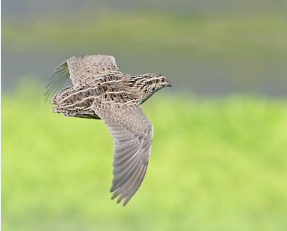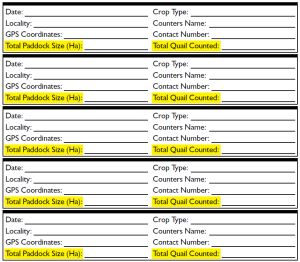
The CWRT is supporting a citizen science project where volunteers are being sought to gather data to help boost knowledge of the Stubble Quail population in South Australia.
This project focuses on counting Stubble Quail during harvest operations, where they can be regularly seen flushing in front of headers reaping crops on farming land. For some, counting quail may provide an opportunity to help a long day in the harvester seem a little shorter than it is.
Aim:
The project which has been running since 2021 aims to detect the presence and estimate the abundance of Stubble Quail (Coturnix pectoralis) across the agricultural regions of South Australia. Such information is not being collected or assessed in any other way.
Method:
Volunteers are asked to count the number of birds flushed (either flying or running) while harvesting the crop. To prevent double-counting of birds, volunteers are advised not to count birds that land back in a crop area yet to be harvested.
Reporting:
It is recommended that those counting quail use a notebook or ‘Tally Counter App’ on their smartphones to record each flushing. Once a paddock has been completely or partly harvested (if you can estimate the area of the partly harvested section), volunteers should tally up the count and record it (along with the other information requested) on a downloadable data form or by using the online survey form along with the other information requested. Completed downloadable data forms can be emailed or sent via SMS to the project coordinator listed on the form. We recommend using the online survey form because it may be an easier and faster option for most participants.
If you have any questions or need further information, contact the project’s leader and wildlife biologist Matthew Godson (0448 887 079 or [email protected]).
Images of parts of the downloadable data form:
Images of Stubble Quail




General information about Stubble Quail:

The Stubble Quail Is a large, plump quail with grey-brown streaked upper parts and a cream underside. The male has a chestnut bluff area on his lower face and throat, whereas the female is cream.
Male birds are about 18cm long with females slightly larger. Adult birds weigh around 100g – 110 grams. Adult birds have a wingspan between 25-33cm. Their wings make a loud whirring noise when they take flight which helps identify them.
They have a widespread distribution across most of Australia
Habitat – Stubble Quail live in the grasslands and shrublands of temperate regions, usually in well-watered areas, but will move into arid areas after floods or rain. They prefer tall, dense vegetation, especially grasslands, but will use lower vegetation such as stubble fields.
Seasonal Movements – Some Stubble Quail populations stay in much the same area all year round, but most move around widely, in response to factors like rainfall, growth of vegetation and availability of food.
Feeding – Stubble Quail mainly eat different types of seeds or grain. Young eat insects. They feed during the day when they scratch around on the ground for seeds, grasses and foliage. They have also been seen to climb wheat stalks to pick grain from the heads.
Breeding – is influenced by rainfall, cover and food availability. They can breed any time of the year. They have been known to move into an area after rain breaks a drought and breed in huge numbers with up to four clutches of chicks. Clutch sizes range from 7 – 14 chicks with an incubation period of around 18-21 days
They build their nests on the ground often in areas such as grasslands, paddocks of cereal crops, especially ones with undergrowth, and under small shrubs. The nest is a scrape in the ground lined with dried grass or pieces of nearby vegetation. Only the female sits on the eggs and she will pull surrounding vegetation over the nest as a cover at this stage. The chicks are led away from the nest almost straight away after hatching and are fairly independent.
Land clearing, irrigation, logging and development of pasture have increased available habitat and introduced plants, such as cereals, have increased the availability of food. The range and population size of Stubble Quail have increased since European settlement.

